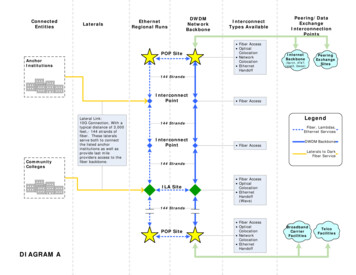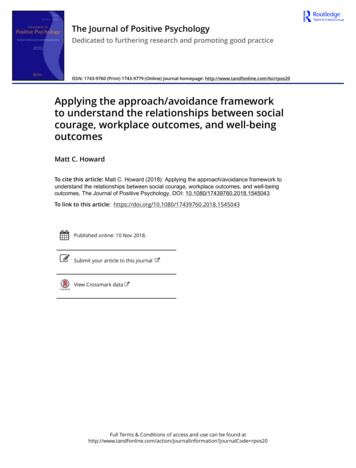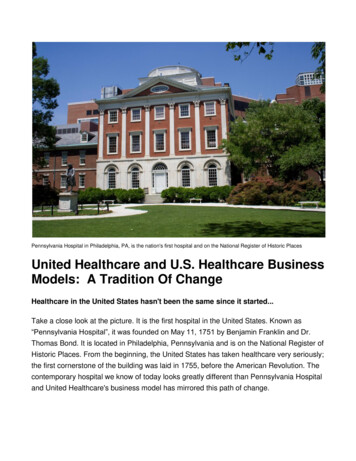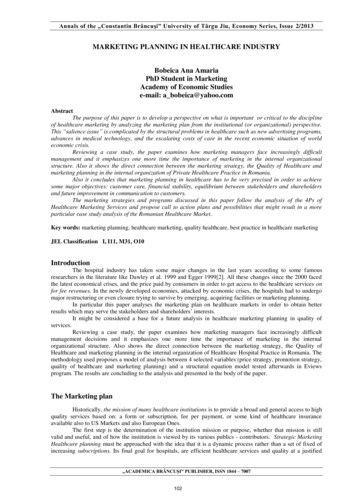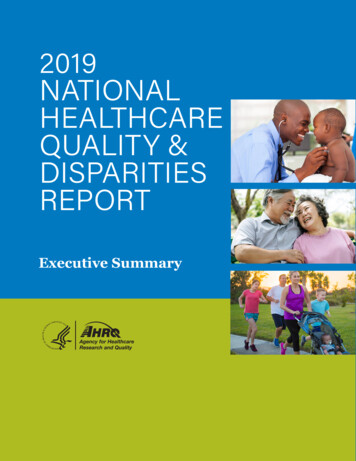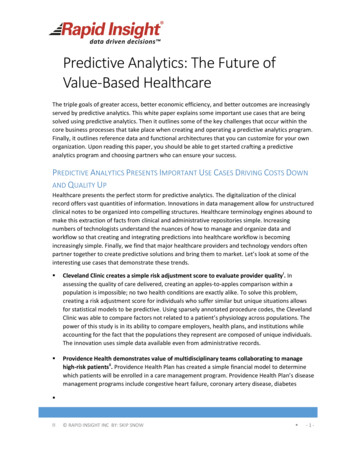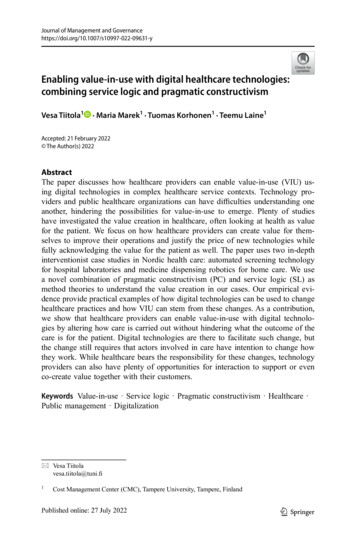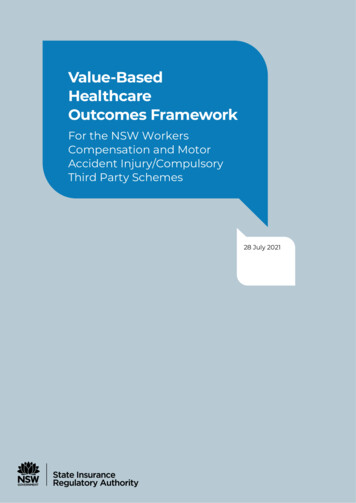
Transcription
Value-BasedHealthcareOutcomes FrameworkFor the NSW WorkersCompensation and MotorAccident Injury/CompulsoryThird Party Schemes28 July 2021
Contents1.A framework for health outcomes at SIRA. 41.1.Purpose of the health outcomes framework . 41.2.SIRA’s vision for healthcare . 51.3.Structure of the health outcomes framework .82.Defining and measuring success in achieving health outcomes . 92.1.What are the domains? . 92.2.What are the desired health outcomes? . 102.3.What are the metrics?. 143.How the health outcomes framework will be used . 153.1.Examples of how the health outcomes framework can be applied in practice . 163.1.1.The research, evaluation and experience investigation process . 163.1.2.Informing assessment, case planning and matched service delivery . 174.Implementation plan for the health outcomes framework . 184.1.SIRA’s healthcare transformation journey . 184.2.Phasing of the design and implementation of metrics underpinning theoutcomes . 204.3.Proposed metrics for Horizon 1 of the value-based healthcare transformation . 224.4. Proposed priority metrics for Horizons 2 and 3 . 304.5.Implementation considerations . 324.6. Governance of the health outcomes framework . 334.7.Proposed roles and responsibilities . 335.Plan for engagement and co-design . 375.1.The need for engagement and co-design . 375.2.Objectives for engagement and co-design. 385.3.Immediate next steps. 38Appendix A: Development of the health outcomes framework . 39Appendix B: Development of metrics . 40Bibliography . 40Principles for metrics . 41State Insurance Regulatory Authority 2
List of abbreviationsTable 1: List of abbreviationsAbbreviationDefinitionCTPCompulsory Third PartyDWGData Working GroupICFInternational Classification of Functioning, Disability and HealthNSWNew South WalesQoLQuality of LifeRTAReturn to ActivityRTWReturn to WorkSIRAState Insurance Regulatory AuthorityWCWorkers CompensationWHOWorld Health OrganisationState Insurance Regulatory Authority 3
1.A framework for health outcomes at SIRAThe State Insurance Regulatory Authority’s (SIRA’s) legislative objectives 1 are to:minimise cost to the community of workplace injuries and injuries arising frommotor accidents; promote the efficiency and viability of the NSW workerscompensation (WC) and compulsory third party (CTP) 2 schemes; and ensurethat persons injured in the workplace or in motor accidents have access totreatment that will assist in their recovery.SIRA is committed to implementing value-based healthcare within the WC andCTP schemes. Value-based healthcare will support recovery, and improve returnto activity, return to work and quality of life outcomes for people injured at workand on the road.To determine whether value is being delivered from healthcare expenditure,health outcomes must be measured and understood. The Value-BasedHealthcare Outcomes Framework (‘the health outcomes framework’, or ‘theframework’) is fundamental to achieving this.This document provides an overview of SIRA’s health outcomes framework, anda series of proposed metrics. SIRA considers this framework to be aspirationaland that the supporting data collection, monitoring and evaluation capabilitieswill need to be built over time.This document is therefore published as a statement of intent to guide furtherco-design and implementation. SIRA’s intention is that the frameworkcontinues to evolve in partnership with scheme participants.In July 2020, SIRA published a consultation paper on the draft framework 3. Thisdocument provides a refined version of the framework, incorporating feedbackfrom public submissions.1.1.Purpose of the health outcomes frameworkTo determine whether value is being achieved from healthcare expenditure, healthoutcomes must be measured and understood.The health outcomes framework underpins the delivery of value-based healthcare byproviding a transparent and systematic approach to monitoring and reporting on theachievement of health outcomes consistent with SIRA’s objectives.Throughout the framework, ‘health outcomes’ refers to outcomes relating to both injuredpersons 4 covered by the WC and CTP schemes, and the wider healthcare ecosystem inwhich these schemes exist (including, for example, outcomes relating to healthcareprovider experience, and the cost and efficiency of healthcare).As defined by the State Insurance and Care Governance Act 2015.The 2017 compulsory third party (CTP) scheme, established under the Motor Accident Injuries Act 2017(MAIA).3SIRA (2020), Health outcomes framework for the NSW Workers Compensation and Motor AccidentInjury/Compulsory Third Party Schemes: Consultation paper (21 July 2020).4While each of the personal injury schemes uses specific terminology – ‘injured workers’ in workerscompensation and ‘injured people/persons’ in compulsory third party – throughout this report, the term‘injured persons’ is used to refer to individuals covered by either scheme.12State Insurance Regulatory Authority 4
“Knowing the outcomes achieved by health services is essential to being able toachieve the greatest benefit, the best patient care, from the resources used.”– Office of Health Economics 5The framework defines a set of outcomes to be delivered for healthcare that is providedwithin the personal injury schemes regulated by SIRA, and a series of aspirational metricsby which progress towards these outcomes can be measured and assessed.The framework has been developed to support healthcare providers 6, insurers/claimagents, employers and other participants in the healthcare ecosystem to adopt anoutcomes-focused approach to support the delivery of value-based healthcare.As regulator of these personal injury schemes and through its legislative functions, SIRAplays a key role in enabling health outcomes for injured persons. The framework istherefore also intended to support the processes and mechanisms which enable SIRA to: support insurers/claim agents to facilitate the delivery of value-based healthcare, provide information to injured persons to promote informed choices, promote continuous clinical improvement, measure population health outcomes associated with improvements in theprovision of healthcare and experience of participants, and gather information to support supervision activity and policy.In this way, the framework will allow scheme participants to improve their understandingof the health outcomes experienced by injured persons, measure progress towards thedelivery of value-based healthcare, and determine the extent to which SIRA’s legislativeobjectives relating to the delivery of healthcare are being achieved.1.2.SIRA’s vision for healthcareAt the heart of the framework is a vision for healthcare within the personal injury schemeswhich SIRA regulates. This vision drives how success is viewed and measured with respectto health outcomes.SIRA’s vision for healthcare is:“The WC and CTP schemes assist injured persons in their recovery throughvalue-based healthcare.”As illustrated in Figure 1, value-based healthcare is focused on achieving measurableimprovements in an injured persons’ meaningful health outcomes relative to the resourcesutilised in achieving those improvements 7,8. This requires targeted interventions thatacknowledge the complex relationship between an injury or illness and the resultant levelsof participation in life or work activities.5Chauhan D, Sussex J (2008), NHS Outcomes, Performance and Productivity, Monographs, Office ofHealth Economics, number 000244.6Expanding the health outcomes framework to explicitly reference non-clinical and social (includingattendant care) providers is an area for future exploration, to be considered in the context of SIRA’s valuebased healthcare transformation.7Porter ME, Teisberg EO (2006), Redefining Health Care: Creating Value-Based Competition on Results.Boston, MA: Harvard Business School Press.8Teisberg E, Wallace S and O’Hara S (2020), Defining and Implementing Value-Based Health Care: AStrategic Framework, Academic Medicine, 95(5), 682-685.State Insurance Regulatory Authority 5
Figure 1: Overview of value-based healthcare 9The definition of value-based healthcare used in the framework is consistent with theprinciples and definitions set out by NSW Ministry of Health 10. This includes the fouressentials of value known as the Quadruple Aim 11 for delivery of healthcare that improves: health outcomes that matter to patients, experiences of receiving care, experiences of providing care, and effectiveness and efficiency of care.Figure 2 outlines the ways in which a value-based approach to healthcare supports SIRA’slegislated purpose in relation to the personal injury schemes.Adapted from Porter M, et al. (2014), Value-Based Health Care Delivery, Available /3 13615129-eeec-4987-bf1a-1261ff86ae69.pdf.10NSW Ministry of Health (2019), Value based healthcare, Available at:https://www.health.nsw.gov.au/Value.11An extension of the Institute for Healthcare Improvement (IHI) Triple Aim (Available ).9State Insurance Regulatory Authority 6
Figure 2: Legislative purpose of SIRA’s personal injury schemesState Insurance Regulatory Authority 7
1.3.Structure of the health outcomes frameworkThe framework starts with SIRA’s objectives in relation to the schemes, which providecontext for the vision for healthcare. The vision for healthcare is divided into outcomedomains, each containing a set of outcomes defining success for healthcare providedwithin the schemes. Individual metrics then provide quantitative measures of progressagainst each of these outcomes 12.The structure of this framework is depicted in Figure 3.Figure 3: Structure of the health outcomes frameworkOutcome domainsOutcomesMetricsDomains are the headline,or principal areas intowhich the individualoutcomes are organised.They represent the keydimensions of the visionfor healthcare in the WCand CTP schemes.Outcomes are statementsthat define success inrelation to driving valuebased healthcare in thepersonal injury schemesregulated by SIRA.Metrics are measurablequantities by whichprogress towards therelated outcomes can beassessed. They representthe extent to which theoutcomes have been or arebeing achieved, providinga measure of success.The components of the framework are supported by: Purpose statement – A statement of the vision for healthcare in the WC and CTPschemes, and a description of the intended purpose of the framework. Implementation plan – A high-level implementation plan for building capability inmeasuring and driving improvement in health outcomes through application of theframework. Plan for engagement and co-design – A plan for further engagement and codesign with scheme participants to agree metrics, refine the implementationapproach, and determine roles and responsibilities for the implementation andapplication of the framework.SIRA’s intention is that the health outcomes framework continues to evolve in partnershipwith scheme participants under a value-based healthcare approach. This will include thedevelopment of additional metrics as capability is built in the areas of data collection,monitoring and evaluation.Quantitative measures may be complemented with insights from qualitative sources (for example,clinical notes) as part of targeted investigations and evaluations. See Section 3.1.1 for further information onthe research, evaluation and experience investigation process.12State Insurance Regulatory Authority 8
2.Defining and measuring success in achieving healthoutcomes2.1.What are the domains?In SIRA’s health outcomes framework, success is defined through clearly articulated healthoutcomes that are organised into six domains.Each domain addresses a key dimension of achieving the vision of value-based healthcare.The domains are structured by those relating to the injured person, and those to the widerhealthcare ecosystem in which the personal injury schemes regulated by SIRA exist.Figure 4 provides an overview of the framework.Figure 4: Domains of the health outcomes frameworkState Insurance Regulatory Authority 9
The health outcomes framework is headlined by the vision to assist injured persons in theirrecovery through value-based healthcare.SIRA is responsible for regulating the WC and CTP schemes, rather than providing, ormaking decisions relating to healthcare services for individual injured persons. Accordingly,this vision will be achieved in partnership with the insurers/claim agents, employers andfamilies who provide a primary interface between SIRA, the injured person and thehealthcare ecosystem. This is further supported by the healthcare providers who SIRA mayinfluence either directly (for example, through approval mechanisms in the WC scheme) orindirectly (for example, via insurers/claim agents, employers, health regulators and peakbodies, and through monitoring and reporting activities).The vision is enabled by the six surrounding domains that reflect the areas in which SIRAintends to measure and monitor outcomes that support progress towards this vision.Each domain describes an area of health outcomes for either the injured person, or thehealthcare ecosystem more broadly. Specifically:1) Physical and mental health – Injured persons recover physical and mental health.2) Wellbeing – The multi-dimensional nature of the wellbeing of injured persons isrecognised, assessed, managed and monitored to actively support recovery, returnto activities/work and quality of life.3) Injured person experience and accessibility – Injured persons have a positivehealthcare experience and services are accessible in a timely manner.4) Safety and quality of healthcare – Healthcare provided within the WC and CTPschemes is the right care, at the right time, in the right setting, and is deliveredsafely.5) Provider expertise, delivery and experience – Healthcare providers within the WCand CTP ecosystem have the right expertise, are engaged, integrated and cansustainably provide value-based healthcare.6) Effectiveness and efficiency of healthcare – Healthcare provided within the WCand CTP schemes is both effective and efficient.2.2.What are the desired health outcomes?Within each domain, the health outcomes framework defines a set of outcomes thatcollectively define success in relation to achieving that aspect of SIRA’s vision forhealthcare.These outcomes reflect the desired improvements in: physiology, functioning, activity participation and quality of life for injured persons;and quality, effectiveness, efficiency and experience for the WC and CTP schemes andparticipants in their healthcare ecosystems.Defining these outcomes is intended to support ongoing planning, evaluation andresponse activities. This will provide greater clarity on SIRA’s objectives relating to healthoutcomes, and improved transparency and accountability, contributing to more effectivesupervision and regulation.Table 2 provides an overview of the desired outcomes across the six domains, including amapping of each outcome to the pillars of the Quadruple Aim.State Insurance Regulatory Authority 10
Table 2: Summary of health outcomes by domainDomainsOutcomes1. Physical and mental healthInjured persons recover physical and mentalhealth 1.1 Physical and mental health is improved ormaintained 1.2 Functioning is improved or maintained 1.3 Towards zero harmful dependence onhealthcare 2.1 Holistic wellbeing is taken into account2.2 Return to activities/work in an appropriatetime period2.3 Injured persons have a sense of self-efficacy2.4 Social and environmental factors areconsidered to support return to activities/workand quality of life2.5 Injured persons actively participate in theirown recovery2. WellbeingThe multi-dimensional nature of the wellbeingof injured persons is recognised, assessed,managed and monitored to actively supportrecovery, return to activities/work and quality oflife 3. Injured person experience and accessibilityInjured persons have a positive healthcareexperience and services are accessible in atimely manner 3.1 Healthcare is accessible in the right place, atthe right time3.2 Healthcare is inclusive and responsive3.3 Healthcare is integrated3.4 Satisfaction with the healthcare experience3.5 Satisfaction with the claims experiencewhere it is related to healthcare4. Safety and quality of healthcareHealthcare provided within the WC and CTPschemes is the right care, at the right time, inthe right setting, and is delivered safely o o4.1 Healthcare is person-centred and high quality4.2 Low value healthcare is minimised4.3 Healthcare reflects innovative leadingpractice4.4 Healthcare is delivered safely4.5 Healthcare is driven by information5. Provider expertise, delivery and experienceHealthcare providers within the WC and CTPecosystem have the right expertise, areengaged, integrated and can sustainablyprovide value-based healthcareoooo5.1 Providers have the right expertise5.2 Provider wellbeing, engagement andsatisfaction is improved or maintained5.3 Providers integrate and collaborate5.4 Providers exhibit value-based behaviours6. Effectiveness and efficiency of healthcareHealthcare provided within the WC and CTPschemes is both effective and efficient 6.1 Healthcare is cost and resource efficient indelivering outcomesKEY: Alignment with the pillars of the Quadruple Aim for delivery of healthcareImproved health outcomes that matter to patientsImproved experiences of receiving careImproved experiences of providing careImproved effectiveness and efficiency of careEach outcome is intended to benefit specific stakeholder groups. A detailed description ofeach outcome and the primary target beneficiaries 13 is captured in Table 3 below.It should be noted that secondary benefits are expected throughout the ecosystem. For example, activeparticipation in recovery benefits the injured person primarily, but could flow on to lower claims costs andtherefore lower premiums.13State Insurance Regulatory Authority 11
Table 3: Summary of health outcomesState Insurance Regulatory Authority 12
State Insurance Regulatory Authority 13
2.3.What are the metrics?The health outcomes framework aims to provide guidance and a structure to measureprogress towards and achievement of health outcomes through a series of quantifiablemetrics.As SIRA is in the early stages of co-designing its value-based healthcare transformation, notall aspects of the framework are readily quantifiable. Accordingly, this document contains alist of aspirational metrics. SIRA plans to partner with the sector to validate and further codesign the proposed metrics to support the framework.It is anticipated that these metrics will continue to evolve as SIRA progresses through itsvalue-based healthcare transformation, and in response to feedback from the sector, futurerefinements to the framework, as well as advances in the availability of data.A roadmap for the implementation of the health outcomes framework and thedevelopment of metrics is provided in Section 4 – Implementation plan for the healthoutcomes framework. This section also contains a series of proposed metrics for the firstimplementation horizon, and proposed priority metrics across future horizons.SIRA intends to continue to collaborate with the sector to refine the metrics presented inthe document. A plan for engaging with the sector to finalise the metrics and roles andresponsibilities in included in Section 5 – Plan for engagement and co-design.State Insurance Regulatory Authority 14
3.How the health outcomes framework will be usedApplying the framework across the design, delivery and evaluation of healthcare serviceswill facilitate a better understanding of the extent to which these services support therecovery, return to activity, return to work and quality of life for injured persons, andtherefore the extent to which expenditure on healthcare in the schemes is delivering value.SIRA’s intention is that the health outcomes framework is applied for the purposesdescribed below.Table 4: Potential applications of the health outcomes frameworkApplicationDescriptionService designBy building a common understanding of the desired health outcomesfor injured persons and the broader healthcare ecosystem, theframework will guide targeted and collaborative service design undera value-based healthcare approach. Furthermore, a focus onoutcomes for injured persons will encourage innovative servicedesign.Assessment andcase planningBy encouraging the assessment and acknowledgement of thebreadth of factors that may impact an injured person’s recovery andachievement of health outcomes, the framework will promote riskstratification and segmentation, targeted case planning, andequitable access to healthcare interventions matched to needs.Service deliveryBy providing a mechanism to distinguish between high and low valuecare, the framework will guide and support all participants in thehealthcare ecosystem in adopting an outcomes-focused approach toservice delivery.Monitoring,research,evaluation andexperienceinvestigationBy identifying metrics to support the desired outcomes, and amaturity journey to build the capabilities required to embed thesemetrics, the framework will promote consistency of measurement andevaluation of healthcare services. The focus will be on achievement ofhealth outcomes that matter to injured persons. This will allowstakeholders to conduct monitoring, research, evaluation andexperience investigation activities, to identify opportunities forimprovement.PerformancemanagementBy articulating SIRA’s expectations for the achievement of healthoutcomes for injured persons and the broader healthcare ecosystem,the framework will support other regulatory tools as a basis foroutcomes-focused supervision and performance managementactivities.ContinuousimprovementBy increasing transparency of the health outcomes experienced byinjured persons within SIRA’s personal injury schemes, the frameworkwill foster innovation, learning and continuous improvement amonghealthcare providers, insurers/claim agents, employers and otherparticipants in the healthcare ecosystem.All stakeholders within the WC and CTP schemes are encouraged to consider additionalapplications of the framework within their own context.State Insurance Regulatory Authority 15
3.1.Examples of how the health outcomes framework can be applied inpractice3.1.1.The research, evaluation and experience investigation processIt is expected that the health outcomes framework, and associated monitoring andreporting approaches, will be enhanced and refined over time. This will be achievedthrough an iterative process of research, evaluation and experience analysis, includingconsultation with SIRA’s internal and external stakeholders.Each metric supporting the health outcomes framework can be categorised into one ormore of the following classifications: Individual assessment and monitoring – Where a metric is expected to becollected at (or prior to) the time of injury or claim, to be used in the assessment andtriage of an injured person to ensure appropriate case planning and access tohealthcare that meets their individual needs. Portfolio-level monitoring and reporting – Where a metric is expected to becaptured and reported on at regular time intervals, such as monthly, quarterly, oryearly. Because of the consistent nature of their reporting, these metrics can bepresented in a reporting dashboard to allow for monitoring of outcomes at theportfolio level. Research, evaluation and experience investigation – Where a metric is capturedon a less frequent basis but has applications in one or more of the areas listed below. Research – Metrics used to investigate new trends or to test hypotheses.Research relates to exploratory analysis as part of a defined project which mayinclude one off data collection. Evaluation – Metrics to be used to understand the impact of a change toservices, processes and/or policies, and assess whether this impact is in line withexpectations or desired outcomes. Metrics may be collected and reported on atkey intervals over a defined evaluation period (for example, over a three-yearevaluation period, with data collected at key points in time). Experience investigation – Metrics that enable a deep dive into a more specifictopic or trend deemed to be of high priority at the time of investigation. Themetrics are typically more suited to ad-hoc or semi-frequent collection andreporting.As research, evaluation and experience investigation exercises enable participants withinthe personal injury schemes to increase their understanding of the underlying factorswhich influence the achievement of health outcomes, the health outcomes framework andsupporting metrics will be enhanced.Figure 5 illustrates the continual evaluation process that will guide the further refinementand development of the health outcomes framework, and inform future policy, service andprocess design more broadly.State Insurance Regulatory Authority 16
Figure 5: Healthcare evaluation lifecycleThroughout the evaluation process, consideration must be given to when and how toengage with both internal and external stakeholders.3.1.2.Informing assessment, case planning and matched service deliveryThe health outcomes framework reflects a combined health and wellbeing approach thatacknowledges and targets the breadth of factors that may impact an injured person’srecovery.Healthcare providers may use the health outcomes framework as part of an individualassessment process. The outcomes framework provides a structure and proposed metricsto acknowledge and measure needs relating to body system or structure physiology,functional limitation and participation in life or work activities 14, in line with abiopsychosocial approach.Assessment of individual needs in these areas will allow healthcare providers to targetservices to best support recovery, and achievement of return to activity, return to work andquality of life outcomes.Systematically measuring and monitoring needs relating to body system physiology,functional limitation and activity participation is crucial to the ability to deliver matchedcare under a value-based healthcare approach. Routine measurement of these needs willcreate new sources of data aligned to the health outcomes framework, which will allowadditional metrics to be implemented in regular monitoring and reporting activities. Inturn, this will increase capability in measuring progress towards, and achievement of,health outcomes.In line with the World Health Organisation’s (WHO’s) International Classification of Functioning, Disabilityand Health (ICF): physiology and physiological needs reflects ‘impairment’ as it refers to a problem with abody part structure or function; functional limitation reflects ‘disability’ as it refers to the consequences ofthe ‘impairment’ as they relate to execution of tasks; and ‘activity participation’ refers to the subsequentdegree of involvement (or not) in life and/or work activities.Source: World Health Organization (2001), International Classification of Functioning, Disability andHealth, World Health Organization, Geneva.14State Insurance Regulatory Authority 17
4.Implementation plan for the health outcomesframework4.1.SIRA’s healthcare transformation journeyDefining the health outcomes framework is an initial step towards achievin
WC Workers Compensation : WHO World Health Organisation . State Insurance Regulatory Authority 4 . 1. A framework for health outcomes at SIRA . . Strategic Framework, Academic Medicine, 95(5), 682-685. State Insurance Regulatory Authority 6 . Figure 1: Overview of value-based healthcare. 9.

